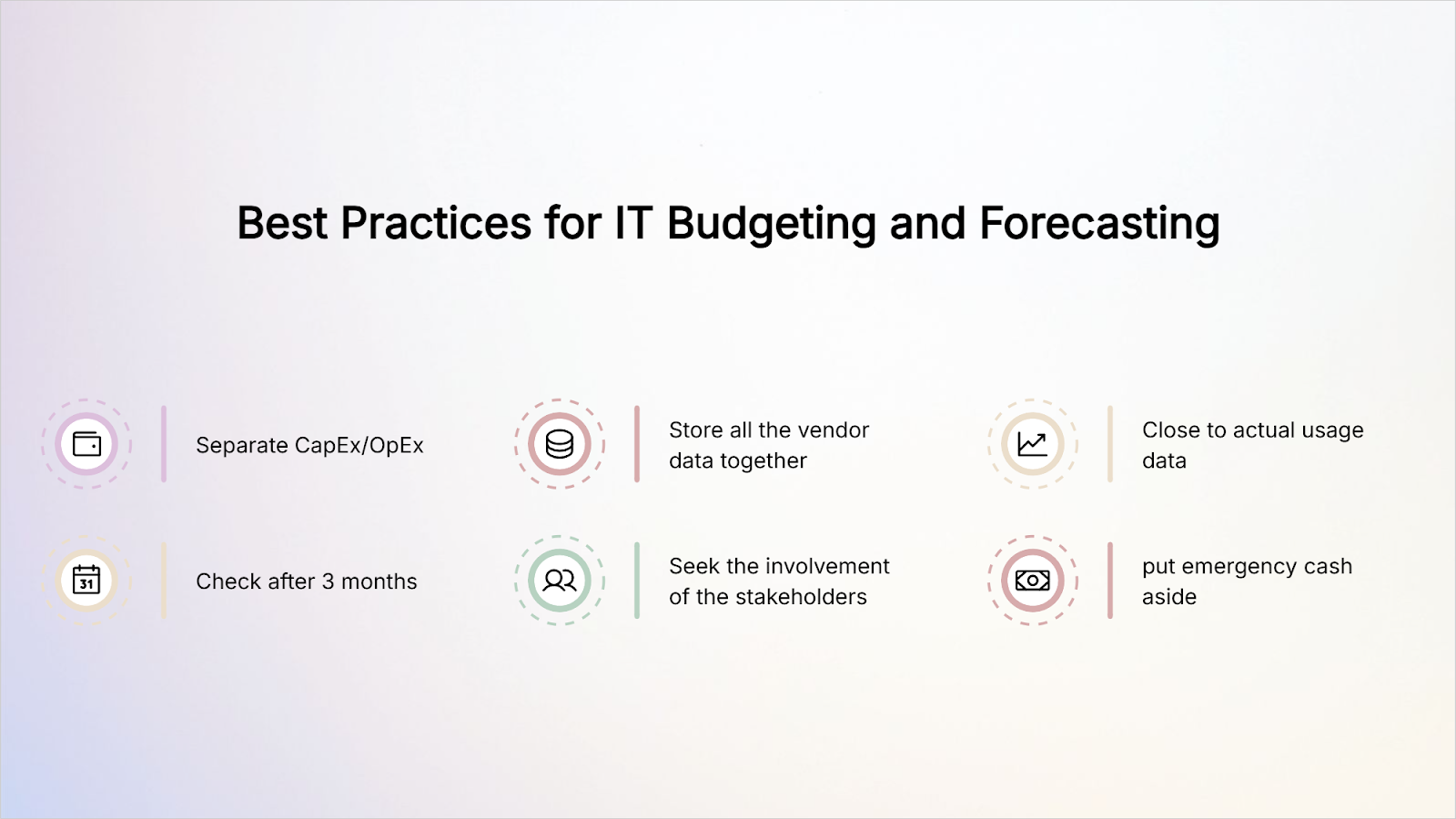

IT Budgeting & Forecasting: A Complete Guide for 2025

IT Budgeting & Forecasting: A Complete Guide for 2025
Learn IT budgeting and forecasting strategies to cut costs, optimize cloud and SaaS spend, and plan smarter for agile, business-aligned growth in 2025.


Peter Drucker said you cannot manage what you do not measure. That rings true in enterprise IT. Many teams carry half-used SaaS licenses, and about a third of cloud spend goes to waste. The cost is not just financial. Untracked renewals, usage spikes, and hidden fees erode trust and slow projects.
The fix is a steady practice of budgeting and forecasting, not last-minute cuts. Measure usage, spot waste early, and plan renewals with real data. Tie every dollar to a clear outcome so spending supports growth, security, and uptime. Platforms like Spendflo help by showing usage, contracts, and savings in one place.
What Is IT Budgeting?

IT budgeting is the ongoing process of planning, allocating, and controlling technology spend so it supports daily operations and growth. It covers hardware, software and SaaS, cloud services, staff and training, and security and compliance, aligning each dollar with business goals and reducing risk.
What is IT Forecasting?
IT forecasting estimates future technology needs, usage, and costs so teams can plan budgets and capacity with confidence. It projects cloud consumption, SaaS licenses, hardware refresh, staffing, and renewals, tests scenarios against business goals, and flags risks early to avoid surprises and overspending.
How do IT budgeting and forecasting work together?
Budgeting sets the spending plan and forecasting predicts needs and usage. They work in a loop where you project SaaS seats, cloud consumption, hardware refresh, staffing, and renewals, then set quarterly targets. Each month you compare actuals to plan, update the forecast, and keep the plan realistic.
When gaps appear, you right size licenses, shift funds to higher impact work, or pause low value items. Before big projects or renewals, you revisit scenarios to avoid surprises. A platform like Spendflo helps with live SaaS usage, contract terms, and renewal dates so midyear changes are fast and well grounded.
Rolling Forecast: A Dynamic Approach to IT Planning
The yearly budgets are not always sufficient in the current IT environment. Conventional plans assume that costs will be similar all year round but the IT environments are anything but predictable. Financial uncertainty is caused by cloud services, unstable vendor prices, unplanned IT projects and cybersecurity threats.
This is where the process of rolling forecast transitions into a more flexible approach to IT financial management. A rolling forecast, instead of using fixed numbers,will update the projections every month or quarterly to ensure alignment between business goals, financial goals, and real-time IT spending trends.
Why Rolling Forecasts Work Better Than Annual Budgets
- Agility
Rolling forecasts let you adjust quickly when markets shift or vendors change terms. You can move funds from low value tools to higher impact work without waiting a year. Teams respond faster to new security needs or AI pilots. The plan stays current because you refresh it on a regular schedule.
- Accuracy
Estimates improve when you use live data instead of last year’s guesses. Pull actuals from finance, SaaS usage, and cloud analytics to see what is really happening. Right size licenses and compute before costs drift. Over time the forecast gets tighter and surprises get smaller.
- Visibility
Leaders get a clear view of cash flow, IT spend, and expected return. Everyone works from the same numbers, so decisions are cleaner and faster. Renewal calendars and owner dashboards show what is coming next. With a platform like Spendflo, usage and contract terms are visible in one place.
To illustrate, when the cost of cloud computing is high in the first quarter because of the increase in server capacity requirements, a rolling forecast will instantly reassign resources until the end of the year. Leaders are not fixed on unattainable financial goals; they are dynamic.
Best Practices for IT Budgeting and Forecasting

To make IT budgeting and forecasting effective, teams should:
Separate CapEx and OpEx
Split long term investments from recurring run costs so planning is cleaner. CapEx covers items like hardware refresh and major upgrades. OpEx covers subscriptions, support, and day to day operations. This helps finance forecast cash needs and depreciation. It also makes approvals faster because everyone knows what bucket pays.
Store all vendor data together
Keep contracts, invoices, usage, and renewal dates in one system. Assign an owner for each vendor and add reminders well before the end date. Central storage reduces missed deadlines and rushed extensions. It also makes audits and board updates straightforward. Teams save time because they are not digging through inboxes.
Stay close to actual usage data
Use live SaaS and cloud analytics rather than rough guesses. Track active seats, feature adoption, storage growth, and compute hours. Update forecasts when patterns change so spend stays aligned with reality. Right size licenses and instances before costs drift. Better data means fewer surprises.
Review after three months
Run a quarterly check to compare plans to actuals. Move funds from low impact tools to higher impact work. Adjust for market shifts, hiring changes, or new compliance needs. Document what changed and why. This steady rhythm keeps the plan useful instead of stale.
Involve stakeholders early
Bring finance, IT, security, and key business leads into the process. Confirm goals, risks, and success measures so tradeoffs are clear. Shared facts speed approvals and reduce rework. Owners know what they are accountable for and when. Better inputs lead to better outcomes.
Set aside emergency cash
Hold a five to ten percent buffer for surprises. Common triggers include cloud overages, urgent security fixes, and faster hiring. Define who can tap the buffer and under what conditions. Track any draw and plan a path to repay it. The cushion protects priority work when conditions change.
IT Forecasting: Managing the Complex and Dynamic Nature of Cloud Infrastructure
The process of forecasting has been enabled by cloud infrastructure to be powerful and complex. Cloud spend increases and decreases in response to demand, unlike fixed costs.
A demand by one new customer base or a seasonal traffic explosion can cause a 20 percent jump in expenses. To manage this:
- Monitoring real-time usage with dashboards that track the trends daily or weekly.
- Set clear thresholds to enable reviews to start early, helping to prevent costs from running out unexpectedly.
- Incorporate cloud data into projections to ensure budgets are based on actual consumption.
When properly managed, cloud forecasting can also convert uncertainty into agility.
How to Optimize IT Budgeting
Optimizing IT budgeting requires a mix of process improvements and the right tools:
Automate renewals and alerts
Set a shared renewal calendar with early reminders for owners and finance. Add usage checks before each renewal so you can right size licenses and seats. Block auto renewals by default and require a quick review before terms roll over. A platform like Spendflo centralizes dates, usage, and approvals so deadlines are not missed.
Compare to market averages
Benchmark price per user, feature tiers, and discount bands for each category. Use recent quotes and peer data to see where you are overpaying. Ask vendors to match credible benchmarks or improve terms with longer commitments. Keep the comparisons in one place so future negotiations start from facts.
Bring contracts together
Consolidate vendors where it makes sense to gain volume leverage and fewer invoices. Align end dates so co termination lets you negotiate the stack as a package. Remove duplicates in crowded categories like collaboration and project tracking. Fewer suppliers mean clearer ownership, simpler audits, and lower run costs.
Adopt real time spend management
Use a system that shows live spend by vendor and category along with usage and renewal status. Track list price versus effective price so discount erosion is easy to spot. Set alerts for spikes in cloud usage and low adoption in SaaS. Spendflo gives midsize teams a single view of inventory, contracts, and savings so midyear changes are quick and well grounded.
How Spendflo Helps With IT Budgeting and Forecasting

IT budgets are under more pressure than ever. Without the right tools, companies risk overspending on SaaS, missing renewals, and running inaccurate forecasts that leave finance and IT leaders scrambling.
One of our clients, a high-growth tech company, saved $375K in annual SaaS costs by consolidating contracts, automating renewals, and gaining real-time visibility through Spendflo. That success story isn’t unique; most businesses discover they’ve been overspending for years once they centralize their vendor data.
If these challenges sound familiar, like dealing with fragmented contracts, manual spreadsheets, or limited visibility, you’re not alone. And without making some changes, those risks can only increase. That’s why Spendflo offers guaranteed results: up to 30% savings on annual software spend and the confidence of having every budget and forecast supported by real-time data.
Ready to take control of your IT budgets? Book a demo with Spendflo today.
Frequently Asked Questions
What is budgeting and forecasting?
Budgeting sets the spending plan for the year, while forecasting predicts needs and usage so the plan stays real. Both run in a loop with monthly updates. You compare actuals to plan, adjust targets, and shift funds to what works. Spendflo helps by showing live SaaS usage and renewals.
What does an IT budget include?
People costs for IT staff and support, plus SaaS and software, cloud services, and security. Hardware and networks, along with projects like migrations or upgrades. A buffer for audits, new rules, or faster hiring. A renewal calendar and owners so no one misses key dates.
What are the 7 steps of forecasting?
Set goals and drivers that matter to the business. Gather clean data from finance, SaaS usage, and cloud analytics. Model scenarios, test assumptions, and pick the one that fits capacity and risk. Convert to quarterly targets, track actuals monthly, and revise often with help from tools like Spendflo.
What are the 4 types of budgeting?
Incremental budgets extend last year with small changes. Zero based budgets rebuild from scratch and fund only what earns its place. Activity based budgets tie spend to the work that creates demand. Rolling budgets keep a live plan by adding a new period each quarter.










.png)




.png)




%20Questions%20to%20Ask%20Vendors.webp)





.avif)





